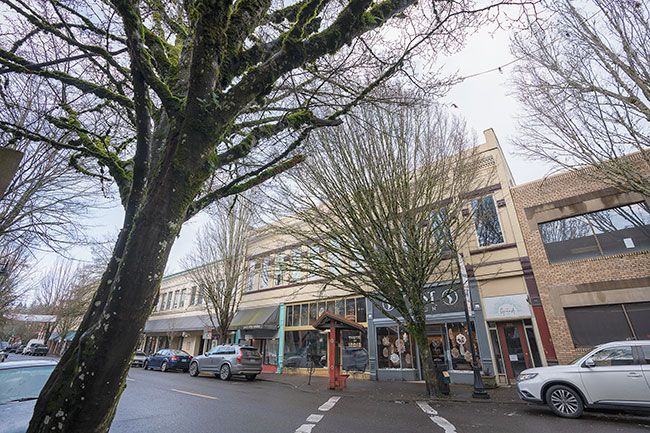City taking long look down Third

The view grew longer, the needs got deeper, and the costs are getting higher, when it comes to Third Street redevelopment planning.
The city of McMinnville won’t have cost estimates for the Third Street Improvement project until the current engineering phase wraps up in July, but staff and consultants made it clear that figure will be higher than the previous estimate of $10 million at a work session Tuesday.
Community Development Director Heather Richards discussed the project’s history and how it has evolved over nearly two decades from an aesthetic streetscape project to a total overhaul of nine blocks of historic downtown.
The work started as an estimated $2.5 million project for three blocks, then expanded to run from Johnson to Adams Street. Later, it became apparent the sidewalks would need to be replaced, which led to a discussion about changing curb lines for more pedestrian and business uses, Richards said.
“If you’re going to change your curb line or your overall right of way, you’re really now in a process of designing a new street, because you’re changing how the street slopes into the curb and the stormwater retention and everything of that nature.”
If the city is going to redo the street, it made sense to have consultants look at underground infrastructure improvements to ensure long-term success, Richards said.
“That’s what we’ve been doing behind the scenes,” she said. “We’ve been evaluating the infrastructure under the road that serves this business community ... and there’s a lot of need there.”
Streetscape improvements and replacing sidewalks was estimated to cost $10 million to $11 million and the work could have been planned to start in 2026 using an estimated $3 million of funding from the city’s Urban Renewal District. Now, with project costs expected to escalate, the timeline will be pushed back and additional funding sources will need to be identified, Richards said.
“We should have that first construction cost estimate in July, but we want to be transparent, establish expectations,” Richards told city council and McMinnville Urban Renewal Advisory Committee members at the joint session. “We expect it to be larger than $10-11 million dollars and we expect our gap to be larger as well...and so that may change the timeframe in terms of when we can implement the project as well because we’ll be looking for more funding than we originally thought.”
MURAC member Mike Morris asked if the project scope could shrink to its original size if costs got out of hand. Richards said that while the scope could be revisited at any step, the sidewalk replacement must be included due to accessibility issues.
Project Advisory Committee Chair and MURAC member Walt Gowell said it would be irresponsible to piecemeal the project.
“Spending millions of dollars on a project to put in new sidewalks in addition to some aesthetic elements and then tearing up a street five or ten years later to do infrastructure repair,” Gowell said. “I would have a hard time justifying that scenario as a responsible use of public funds.”
Additional funding could come from city utility funds, a further maturing UR district and state and federal grants, according to project staff.
Councilor Chris Chenoweth tried unsuccessfully to get an early cost estimate from consultants in an attempt to dissuade feelings of “doom and gloom” around escalating costs.
“We have not started the pricing exercise yet,” consultant Jason White said. “The first step is to finalize the scope, establish the scope and then we’ll put drawings together and prepare the estimate.”
“I’m just trying to get a feel for how much, I mean, I was trying to dissuade the doom and gloom feeling by pointing out that a lot of the funding could come from other vehicles here,” Chenoweth said. “But then I wanted a kind of understanding of what the real doom and gloom looked like, and you’re passing, so I’ll wait until the next time around.”
Richards disagreed with Chenoweth’s characterization, arguing large projects typically evolve and the city is taking necessary steps to ensure long-term improvement.
“I don’t think this is a doom and gloom discussion. We’re finally moving a project forward that this community has discussed for decades,” Richards said. “We’re going through it in a very thoughtful way and it’s evolving and we’re ticking off milestones as we go. So to me, we’re moving towards success and we’re bringing an exciting project to bear.
“We’re building this project and when we’re done it will be the next chapter and legacy for downtown, that’s good.”
While much of consultant Matt Arnold’s presentation was on the criteria for removing street trees (which the project advisory committee has been working on for five months), there was little discussion of trees on the dais, with the joint group generally approving a decision process for removal criteria and an amendment to project goals emphasizing tree preservation.
Initial tree condition criteria is expected to remove approximately 10% of Third Street trees, but that number could grow significantly based on other removal criteria and an upcoming assessment of the trees this spring.
Trees with root issues and those that conflict with planned improvements, the concept plan, or standards set by the agency are also possible candidates for removal.
The consultant team will have a better idea of removal estimates at the July city council meeting, Arnold said.












Comments